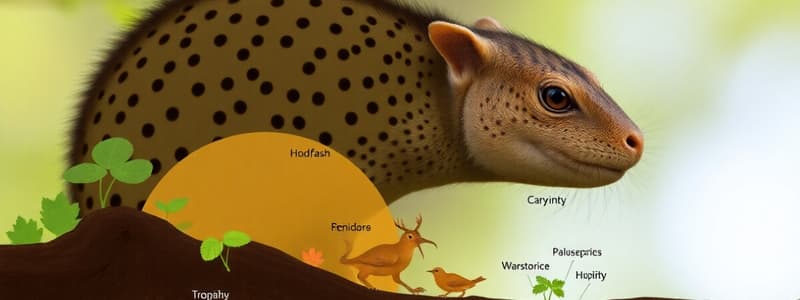Podcast
Questions and Answers
What does the ecological niche of a species include?
What does the ecological niche of a species include?
- What it eats and what eats it (correct)
- Only what it eats
- Its habitat type
- Only its predators
In a food chain, what is the role of producers?
In a food chain, what is the role of producers?
- They consume both plants and animals.
- They are the main consumers in the ecosystem.
- They provide energy for lower trophic levels. (correct)
- They are the final consumers in the food chain.
What do ecological pyramids illustrate?
What do ecological pyramids illustrate?
- The amount of rainfall in different regions
- The relationships between different trophic levels (correct)
- The physical sizes of organisms in an ecosystem
- The distribution of species across biomes
Which of the following correctly identifies a secondary consumer?
Which of the following correctly identifies a secondary consumer?
Which levels of the food chain are primarily composed of herbivores?
Which levels of the food chain are primarily composed of herbivores?
Which statement best describes the Gaia hypothesis?
Which statement best describes the Gaia hypothesis?
What elements constitute the biosphere?
What elements constitute the biosphere?
Which of the following best describes the lithosphere?
Which of the following best describes the lithosphere?
What distinguishes the base of a biomass pyramid from its top levels?
What distinguishes the base of a biomass pyramid from its top levels?
What is a characteristic of agroecosystems compared to natural ecosystems?
What is a characteristic of agroecosystems compared to natural ecosystems?
Acid precipitation can lead to which of the following soil issues?
Acid precipitation can lead to which of the following soil issues?
What impact does acid precipitation have on forests?
What impact does acid precipitation have on forests?
What is a major consequence of acid precipitation for aquatic ecosystems?
What is a major consequence of acid precipitation for aquatic ecosystems?
Which statement is true regarding modern agricultural ingredients in Canada?
Which statement is true regarding modern agricultural ingredients in Canada?
How does acid precipitation affect the economy in Canada?
How does acid precipitation affect the economy in Canada?
What is a consequence of monoculture in agroecosystems?
What is a consequence of monoculture in agroecosystems?
Flashcards
Ecological Niche
Ecological Niche
The role a species plays in its ecosystem, including what it eats, what eats it, and its behavior.
Producers
Producers
Organisms that make their own food through photosynthesis, forming the base of the food chain.
Primary Consumers
Primary Consumers
Organisms that eat producers (plants).
Energy Pyramid
Energy Pyramid
Signup and view all the flashcards
Species
Species
Signup and view all the flashcards
Carnivores
Carnivores
Signup and view all the flashcards
Food Chain
Food Chain
Signup and view all the flashcards
Food Web
Food Web
Signup and view all the flashcards
Biomass Pyramid
Biomass Pyramid
Signup and view all the flashcards
Engineered Ecosystems
Engineered Ecosystems
Signup and view all the flashcards
Monoculture
Monoculture
Signup and view all the flashcards
Acid Precipitation
Acid Precipitation
Signup and view all the flashcards
Environmental Impact of Acid Precipitation
Environmental Impact of Acid Precipitation
Signup and view all the flashcards
Economic Impact of Acid Precipitation
Economic Impact of Acid Precipitation
Signup and view all the flashcards
Buffering Capacity
Buffering Capacity
Signup and view all the flashcards
Study Notes
Ecological Niche
- A species' role in its ecosystem, including what it eats, what eats it, and how it behaves.
- No two species occupy the same niche.
- Producers and consumers obtain energy from different sources.
- Consumers are categorized by what they eat (herbivores, carnivores, omnivores, scavengers).
Food Chains
- Show the feeding relationships among organisms.
- Example: Squirrel eats seeds, weasel eats squirrel, goshawk eats weasel.
- Energy flows through the chain.
- Energy is lost at each level.
Trophic Levels
- Producers (1st level) are photosynthetic organisms.
- Primary consumers (2nd level) eat producers
- Secondary consumers (3rd level and up) eat primary consumers.
- Energy pyramids show how energy decreases at higher trophic levels.
Terrestrial Biomes
- Terrestrial ecosystems are mainly based on the climate.
- Multiple types of biomes exist on Earth.
Modern Agriculture
- Many foods consumed are not native to Canada.
- Agroecosystems differ from natural ecosystems.
- Agroecosystems have uniform abiotic features (less biodiversity) and are more intensely used by humans.
- Require human maintenance.
- Monocultures decrease biodiversity.
- Pests are consumers of crops in agricultural environments.
Acid Precipitation
- Impacts aquatic ecosystems by decreasing pH values.
- Impacts soil by dissolving metals necessary for plant growth.
- Impacts forests by weakening trees, making them more vulnerable.
- Impacts the Canadian economy.
Studying That Suits You
Use AI to generate personalized quizzes and flashcards to suit your learning preferences.
Related Documents
Description
Test your knowledge on ecological niches, food chains, and trophic levels with this quiz. Explore how energy flows through ecosystems and understand the role of different organisms in terrestrial biomes. Challenge yourself to identify key concepts in modern agriculture as well.




